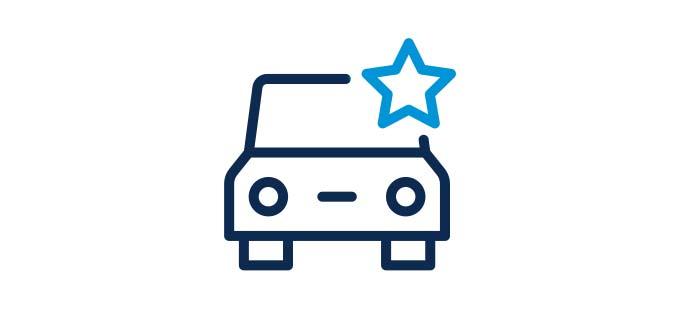
Financial leasing
- You don’t have to pay the supplier anything upfront
- You don’t have to put up any collateral
- You make monthly lease payments (including VAT)
What can you finance with a leasing solution?

A company car
A passenger car or van (electric, new or second-hand)

Business equipment
Office and shop equipment, agricultural and industrial machinery (both new and second-hand).
Whether you've an established business or are just starting one, it’s important to enter your business venture full of enthusiasm and determination. You often need a company car or business equipment but you would rather not use your own capital to fund those investments.
The good news is that KBC has three financing options you can use for this instead: leasing, renting and investment credit.
With financial leasing, you don't have to pay the supplier anything upfront. KBC pays the full amount of the investment to the supplier (including the VAT) and you pay this aggregate amount back to KBC over time.
You get the right to use the goods, but KBC remains the legal owner of your purchases. If you lease a company car, for instance, you get to choose the type of car and the dealership. You also arrange your own insurance separately.
The financial leasing option
With financial leasing, KBC buys the goods and you acquire the right to use them. The purchase invoice is in our name, making KBC the owner. You don’t have to pay the supplier anything upfront. We pay the full investment amount to the supplier (including the VAT).
As soon as you’ve signed the receipt, you start paying back the investment amount (including the VAT) over time via monthly lease invoices.
At the end of the lease, you have the option of buying the goods for their residual value. You have the freedom to decide what type of goods to buy and where, as well as to take out your own insurance separately. The minimum investment amount for business equipment and company cars is 9 000 euros (excluding VAT).
As regards the accounting treatment of leasing, the item is capitalised and depreciated over its useful life in the balance sheet. As standard, the residual value at the end of the lease is 4% for most goods*. If you pay the residual value at the end of the contract, you become the owner.
Example
You lease a piece of machinery worth 25 000 euros (excluding VAT). You have to capitalise and depreciate it afterwards on your balance sheet. Only the agreed residual value (4% as standard, or in this case 1 000 euros, excluding VAT) does not have to be capitalised. This means that the machinery will be recorded on the assets side of the balance sheet with a value of 24 000 euros. Interest may also be deducted as an expense. If you choose to exercise the purchase option when the lease ends, you have to depreciate the residual value on your balance sheet. You can also choose to depreciate it in the following year.
Be sure to speak to your bookkeeper or accountant if you require more information or have any questions in this regard.
*You can change the residual value yourself.
Leasing and renting are similar at first sight, but there are some important differences. As regards the accounting treatment of leasing, you capitalise and depreciate the asset on your balance sheet in a similar way to an investment credit.
With renting, by contrast, you record the invoice in the income statement as an expense. If you want to purchase the asset at the end of the lease/rental, you have to pay the residual value (the standard residual value is 4% for leasing and 16% for renting, but you can change the residual value).
When you opt for a traditional investment credit, you become the full owner of the item you purchase. KBC role is limited to financing it. This means there is no link between the item concerned and the credit, which explains why KBC sometimes requires additional security. However, if you opt for a leasing/renting arrangement, KBC will purchase the items from your chosen supplier. The item itself then serves as security for repayment of the lease.
Your personal preferences and financial situation are important when deciding whether to go for an investment credit, leasing or renting. If you’re still unsure, run a simulation in KBC Mobile or KBC Touch and KBC will suggest the best solution for your business.
Find out which credit facility suits you best for a company car: compare financing for company cars
Find out which credit facility suits you best for business equipment: compare financing for business equipment
- Choose a vehicle or business equipment and ask the supplier to prepare an order form
- Apply for your financing online using KBC Mobile, KBC Touch or the KBC Business Dashboard
- Once your application is approved and the contracts signed online, KBC reconfirms your order
- Upon receipt of the goods or vehicle and after the receipt has been signed, KBC pays the invoice amount to the supplier
- Your contract is activated and you start paying your monthly invoices
- You are free to decide what type of goods or company car to buy and where. The same also applies to any insurance you may require.
- You don’t pay the supplier upfront. KBC pays the full amount of the investment to the supplier (including the VAT).
- You repay the VAT over a longer period and KBC takes care of the prefinancing.
- Accounting treatment via the balance sheet (capitalisation and depreciation).
- If you want, you can buy the goods at the end of the lease for the residual value specified in the contract (4% as standard for leasing, but can be changed).
- You can now conveniently work out online how much leasing costs and immediately apply for it online, as well.
- Important: if KBC feels that your monthly leasing or rental payments would be too high, it will reject the application.
“Our fleet is made up of some 20 vehicles. We’ve gone for KBCs leasing solution for many years now. What’s more, the online app – in my opinion – is the best on the market.
Johan van Dievoet, Eagle Cleaning


